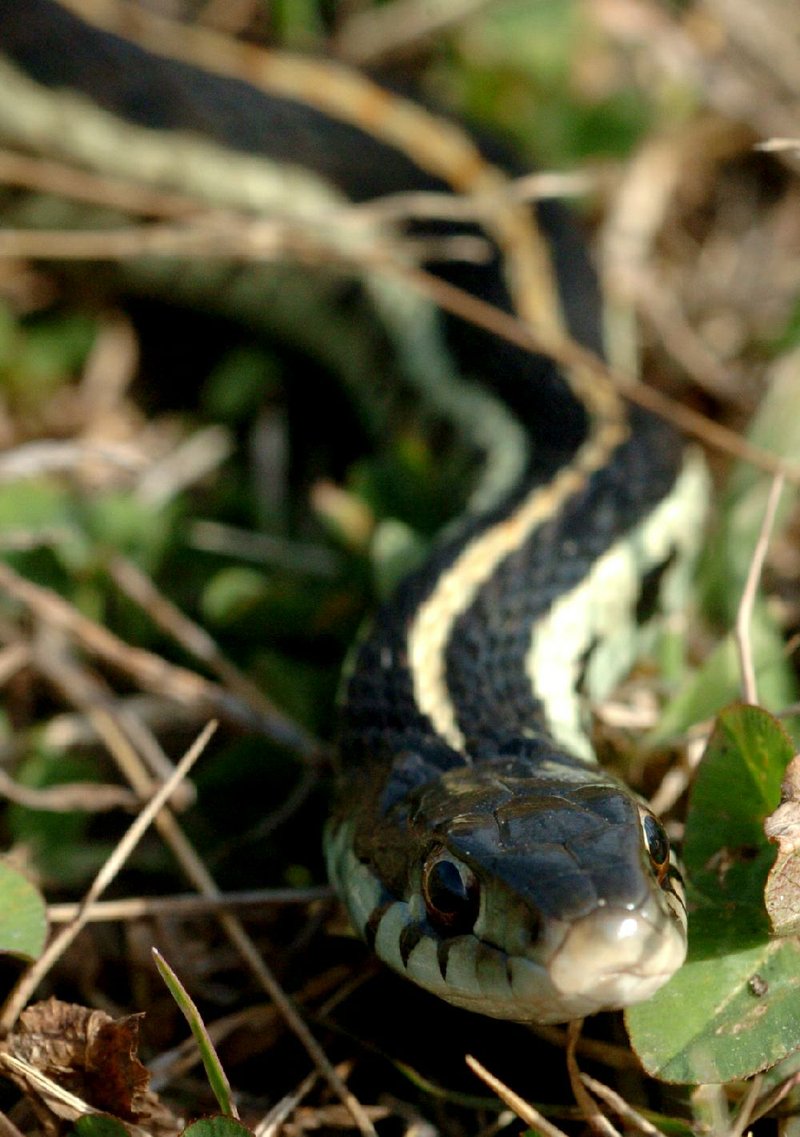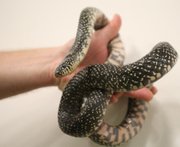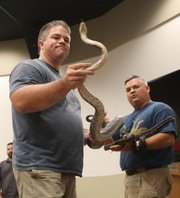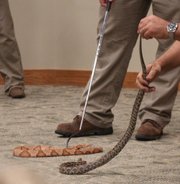Snakes come and snakes go, whether we see them or not. But what if we do see them -- in the backyard?
RELATED ARTICLES
http://www.arkansas…">Stay safe by knowing snakes' active periodshttp://www.arkansas…">State guide labels venomous snakes
Arkansas is home to 36 species of snakes, only six of which are venomous species, according to the Arkansas Snake Guide brochure published by the Arkansas Game and Fish Commission. That means all the rest aren't.
And that means, herpetologists say, chances are good the slithery thing that surprises the horrified homeowner is not a threat -- and it's lurking around for a reason.
"This guy's a big rat trap," Jeremy Sloan of Greenwood said, displaying a long, gray, diamond-patterned Great Plains rat snake to a room packed with children Aug. 27 at the Witt Stephens Jr. Central Arkansas Nature Center.
Members of the Arkansas Herpetological Society, Sloan and Brad Birchfield drew squeals and gasps while handling live examples of snakes that are common around the state. Their nearly two-hour program on the reptiles' behaviors made five main points:
• Most snakes are not venomous.
• People should learn to recognize the venomous species -- copperhead, cottonmouth, coral snake, Western diamondback rattlesnake, timber rattlesnake and Western pygmy rattlesnake.
• Any kind of snake will bite if it thinks it's being killed.
• Snakes are helpful.
• Don't kill snakes.
As guides for the novice and seasoned snake spotter, they recommended the Game and Fish booklet as well as A Field Guide to Reptiles and Amphibians of Eastern and Central North America, part of the Peterson Field Guide Series published by Houghton Mifflin Co.
Also, their society's website, herpsofarkansas.com, includes a "Snake ID" section where anyone can submit a photo of a snake for assessment by experts.
"We get a lot of pictures of decapitated Great Plains rat snakes that say, 'Hey, I just killed a copperhead,'" Sloan said.
Copperheads are, indeed, venomous. The nonvenomous rat snake is patterned with bold geometry, as is the copperhead, but seen side by side, the two look nothing alike. For one thing, the rat snake is gray. Copperheads are brown and tan.
One easy way to identify a copperhead is by the "Hershey kiss" pattern down the side of its body, he said.
It's not just rat snakes, Birchfield of Mountainburg said. People mistake all kinds of harmless snakes for copperheads.
"We often get pictures of little earth snakes and worm snakes -- tiny little snakes that people find in their flowerbed -- and they'll send us a picture of what they believe is a baby copperhead," Sloan said. "A baby copperhead's pattern looks exactly like the adult's."
The tip of its tail will be bright yellow, though. That darkens as the snake ages.
Meanwhile, the mere fact that a copperhead exists is not a good reason to kill it, they said.
In the first place, it's "technically illegal," they said. Under the Arkansas Game and Fish Code 05.10, "Depredation permit requirement," residents don't need a permit to trap or shoot nongame animals "which pose a reasonable threat or endangerment to persons or property." Whether a snake that's minding its own snake business poses a threat is a judgment call but herpetologists say judgment improves when people understand the work snakes do.
Note that "trap or shoot" is not the same as clobbering something with a stick or hacking at it with a hoe.
In the second place, they said, people are most likely to get themselves bitten or bitten again while they're trying to kill a snake.
Say you stumbled onto a copperhead and it did strike, Sloan said. Chances are the first bite would be "dry" and not life-threatening. "It's painful and definitely nothing you want to do again," he said, and you'd best head to the emergency room. Leave the snake and go.
According to the Centers for Disease Control and Prevention's National Institute for Occupational Safety and Health, 7,000 to 8,000 snakebites are reported nationwide every year, resulting, on average, in five deaths. "The number of deaths would be much higher if people did not seek medical care," according to the agency.
But let's say you mistakenly believe the doctor needs to see the snake to treat you, and so you hang around trying to kill it. Successive bites become venomous. Under attack, the snake fights for its life, pumping all the venom it can through its fangs.
"There's no reason to bring these snakes in for identification if you get bit," Sloan said. Emergency room doctors "are going to sit there and watch you, see how the swelling progresses, see what kind of systemic effects set in, and they'll make a decision based on that whether to administer antivenin."
But most snakes are not venomous, and they're only in a person's yard because they were inadvertently invited.
WHAT DO THEY WANT?
Jeremy Chamberlain is an applied bioscience doctoral student at the University of Arkansas at Little Rock finishing his degree with a specialty in herpetology, the branch of zoology that concerns amphibians and reptiles.
Although no one likes to find one in or around his home, snakes are sometimes drawn there for shelter and food, he said.
"The best way to prevent venomous snakes in your yard is just not having the right habitat for them," Chamberlain said. "The reason venomous snakes come into your yard is because they're looking for food or refuge."
During the summer, snakes are drawn to piles of rubbish, leaves, bricks, old cars or pieces of tin because snakes like to be warm but not too hot, Chamberlain said. Snakes like to hide, he said, so keeping your lawn cut and your yard clear is a true deterrent.
If you do see a snake in the yard, Chamberlain said, the best thing is leave it alone. Unless you have a rodent problem, it will likely pass through within a day or two. If you do have a rodent problem, the snake will leave when the rats are gone.
If you have dogs or children you can't trust to leave the snake alone, wildlife removal services will help you out for a fee, he noted. "If there is a potential threat or danger, it's probably better to give one of these organizations a call."
Brett Crow is a technician in central Arkansas for a wildlife removal service, Missouri-based Wildlife Command Center. Homeowners call him for help in removing snakes that venture a little too close for comfort.
The most common snakes he sees are garters, ribbon snakes and king snakes -- all nonvenomous. Crow rarely gets calls about venomous snakes and, when he does, mostly they are misidentified.
"It's not normally what the person thought it was," he said.
Crow said the many products advertised as snake deterrents aren't 100 percent effective. A clean yard without rats and mice in it is the best deterrent.
If the homeowner knows for sure the snake isn't venomous -- let's say a black rat snake is stealing chicken eggs out of the backyard coop -- the homeowner could get a big trash can, Birchfield said, and a broom, and sweep the snake into the can. Put on the lid and move the snake to somewhere else.
"As far as catching them, any snake will bite," he said, "and especially black snakes are bad about that."
Also, relocation's no guarantee another black snake won't move in when that one's out of the way. "Snakes are predators," he said. "If there's a buffet being served, they're going to show up for dinner."
So it would make sense to screen the coop so it's more snake-resistant.
Birchfield said, "Typically if people tell us they have a black snake or a king snake hanging around, a lot of times they are going to have a mouse problem, too. Get rid of the food source, and the snakes will go away."
UNFAIR REPUTATION
Snakes serve an important ecological purpose, Chamberlain said, and killing them is detrimental to the environment. Most notably, they eat disease-carrying rodents.
"It's estimated that one snake eating rats and mice out in the wild is going to take out something like 4,000 ticks out of the population a year," Sloan said.
With prolific birth rates, gnawing teeth and nesting habits that make them likely carriers of fleas and ticks -- which spread diseases like Rocky Mountain spotted fever and ehrlichiosis to people and animals -- rodents wriggle their way into our homes and steal our food far more easily than snakes can. They also bite when cornered.
Rodents are reservoirs of deadly diseases, said Glenn Manning, a biology professor at the University of Arkansas at Monticello.
"Rodents, which are also mammals like you, carry a lot of diseases that transfer back and forth between mammals. The historic ones are the black plague -- bubonic plague -- the hantavirus, the tick diseases. ...
"Snake eats rodents: fewer rodents, fewer ticks, less chance of humans getting diseases," he said.
"Also, the death rate from these diseases is much greater than the death rate from snakes each year."
Snakes also eat other snakes, Sloan noted, including their own offspring: "Turns out, snake is a perfect snake food. Goes down pretty easy."
Celia Storey provided information for this report.
ActiveStyle on 09/05/2016



